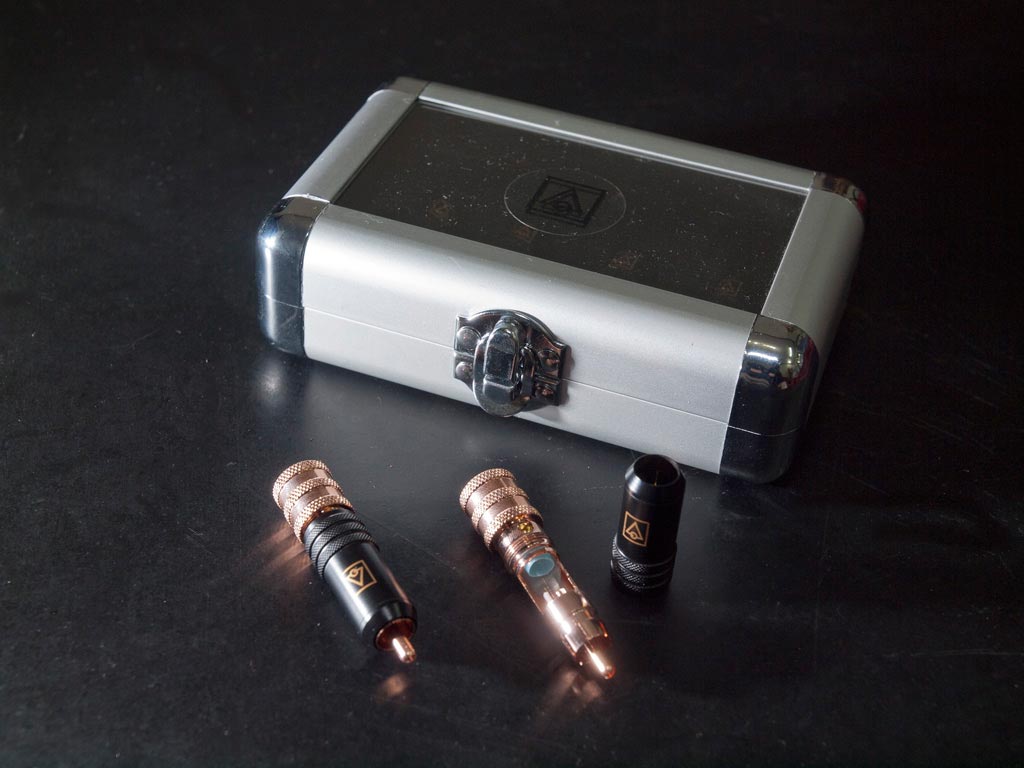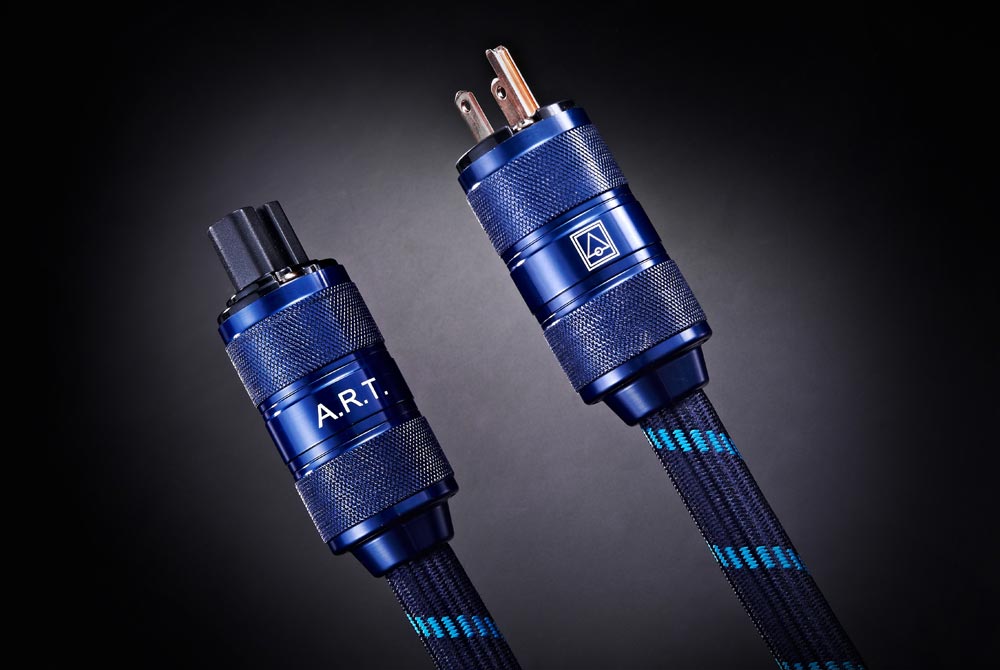L. Borden: Tell us also about the insulators you use.
L. Basagni: There are many types of insulators used in cables such as, cotton/pvc/low density plastic/aluminum foil/metal net/nylon/silk. We incorporate these materials through our cable lines – not necessarily using all the materials into one particular cable. We have our own construction method based on the type of cable and how each of the many layers within the cable are layered.
L. Borden: What factors influence your choice of connectors?
L. Basagni: One of the main influences on how we choose to construct and design our connectors is the balance of sound the connectors can achieve. So the types of material, shape, and overall construction in making the connector all play an important role in the balance of sound.
Further comment by J.L.: I believe a lot of cable makers do not make their connectors in-house. They purchase from different connector brands/companies to be used on their cables. A.R.T. is unique in this area that our connector design is designed and built in-house. Luigi mentions the material, shape, and overall construction plays an important role in the balance of sound – this is one of the developments A.R.T. has recently been looking to improve and has improved upon. We will be launching our new improved connectors to be used with our cables in about April-May. The new connectors will have different shapes, a more noticeable difference on the power cable connectors, and the surface texture and finishes have also been improved. These shape and surface improvements further reduces EMI and vibrations that will affect your sound output. In addition to these improvements, the male plug insert of the power cable is now coated with Rose Gold plating. These improvements also help regulate how and when these connectors release the electrical currents through the cable.
Attached, please find pictures of old versus new connectors for your reference.
L. Borden: Your cables include “Q-Damper” technology. What is this, and what does it do?
L. Basagni: For our cables, the Q-Damper technology is the aerospace grade aluminum magnetization rings you see throughout the length of our cables. These magnetization rings will not always be the same size as the design and construction is all based on the length of the cable, direction of the current, and specially tested to see where they should be placed throughout the cable. These are all factors that drive how our Q-Damper technology is implemented throughout our cables.
Our Q-Damper technology’s main attribute is to even out the vibrations throughout the cable, which brings out clearer and deeper low frequencies, and a more natural sound.
L. Borden: You make cables at three different price points. How do they differ sonically, and in construction? Are they specialized for certain types of systems, for example, tubes vs..
L. Basagni: As far as our SE line of cables go, we have 3 different price points. From low to high: Monolith SE, Synapsis SE, and Super SE. Above Super SE are our Analysts. And above our Analysts is our Sensor (which is not out in the market yet).
Monolith SE is still a great cable but since it’s at our lowest price point we’ll use this as the base. From Monolith SE to Synapsis SE, the latter has all the characteristics Monolith SE has in addition to enhanced, more delicate frequencies. Super SE has all the qualities Synapsis SE has in addition to better dynamics. Analysts has all the qualities Super SE has in addition to a more balanced full range.
Monolith SE and Synapsis SE are constructed with our copper. Super SE is constructed with our copper + silver. And our Analysts are constructed with our copper + silver + gold. The connectors for these cables all follow the same design.
Further comment by J.L.: Furthermore, Monolith SE and Synapsis SE use the same materials and have very similar constructions on the cable. The main difference is the amount of layers and material used in the cable construction. Monolith SE is a thinner cable versus the Synapsis SE – the Synapsis SE has more layers and material.
All the same goes with Synapsis SE versus Super SE, but in addition, Super SE uses Copper + Silver; Monolith and Synapsis use Copper only. And all the same applies to Super SE versus Analysts, but the Analysts uses Copper + Silver + Gold.
L. Borden: In comparing interconnects with speaker cables, the obvious difference is that the latter carries much higher current. How does this influence their design?
L. Basagni: You have mentioned one of the main differences between interconnect and speaker cables. Interconnects need to pay more attention to distortion and signal speed. Speaker cables need to be able to handle higher currents without loss. This is why most speaker cables are thicker in diameter compared to interconnects.
This is also why A.R.T. makes shotgun style (4 cables) Speaker Cables. When you purchase Super SE and Analyst cables (and above), the Speaker Cables are all in shotgun style to handle higher currents smoothly and more effectively.
L. Borden: A.R.T. also makes a number of anti-resonance devices, such the Base Stand, CD Mat Stabilizer, and Tuning Cones. What is their mechanism: Do they absorb vibrations, or channel them away?
L. Basagni: Inside our Base Stands is something we like to call “sound pillars”. These sound pillars reduce vibrations. The Base Stands are made of High Density Graphite + our specialized copper which is mainly used to reduce static electricity.
The CD Mat Stabilizer is not only made of High Density Graphite, but also has specially designed surfaces which have different surfaces on each side of the CD Mat. The High Density Graphite reduces static electricity. The different surfaces are designed to create a down force-like airflow that allows the CD Mat to be effectively sucked onto the actual CD and also minimizes losses that can occur during reading. The holes on the CD Mat, which are the “A.R.T.” letters, are not only for our logo, but also have a purpose of balancing the vibrations through the airflow.
Our Tuning Cones are designed based on the theory that fixed vibration frequencies change the amplitude slope of the air, which consequently changes the voice we hear. These Tuning Cones are able to bring out low to mid to high frequencies and enhance your soundstage, as well as dynamic.
L. Borden: Please share with us your thoughts on the high-end audio industry, and where you see it headed in the coming years.
L. Basagni: Technology definitely has its foot in the high-end audio industry. Technology is moving so fast nowadays, and new methods and materials are being introduced into the industry that it is ever changing. The main point of high end audio products is to regenerate sound to make it as real as possible. I feel like technology is making this more and more achievable. This is what high end audio should be like, and this experience is what audiophiles are owed.
L. Borden: Thank you very much for taking the time to tell us about your company and its myriad products. On behalf of Dagogo and its readers, we wish you continued success.
L. Basagni: Thank you for your interest and time to get to know A.R.T. We hope to be able to share and be a part of your system one day.
- ← Previous page
- (Page 2 of 2)



Hello,
I have two pairs 3m speaker cable A.R.T Basic 2. They have very nice sound. The A.R.T monolith se is better than basic 2 or is about the same cable?
Best Regards
Tasos